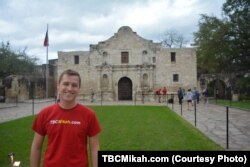San Antonio, Texas, is home to the greatest concentration of Catholic missions in North America, including The Alamo, the state’s first mission dating to 1718. The most visited historic landmark in Texas was also a fort and the site of a battle that played a pivotal role in the state’s dramatic history.
San Antonio Missions
In the 18th century, the government of Spain established Catholic missions in the American southwest, in an attempt to exert control and expand its influence in the region. The Spanish Crown looked upon the natives as potential subjects and saw the missions as a way to convert as many of them as possible to Catholicism.
But the native tribes in what is now east Texas showed little interest in what Spain had to offer. So in 1731, the missions there were relocated westward to the San Antonio River, where, according to the U.S. National Park Service, the hunter-gatherer tribes proved "more receptive" to the Spanish message. Upon entering a mission, tribal members were expected to give up their traditional life, accept a new religion and pledge loyalty to a distant and unseen king.
Most of the missions lasted as fully functional religious sites for six decades.
A perfect union
National parks traveler Mikah Meyer, who’s on a quest to visit all of the more than 400 sites within the U.S. National Park Service, described the relationship between the Spanish government and its Catholic priests as “a perfect marriage.”
“The Crown of Spain wanted to expand the territory and the Catholic priests wanted to help spread [Catholicism], so within that, it was kind of a magical partnership,” he said. “So these mission sites preserve a lot of that heritage."
Today the National Park Service operates the San Antonio Missions National Historical Park, which helps preserve four of the five missions -- San José, Concepción, San Juan and Espada. They were added to the list of national parks in 1978 under then-President Jimmy Carter.
Meyer traveled on the scenic Mission Hike and Bike Trail that follows the San Antonio River and links all five sites. "Each of these mission sites tells part of the story in a different way, depending on how much of the site has been preserved," he remarked.
"The outlying walls and buildings showcase where the religious figures would have lived, where the students would have lived who were being taught by the missionaries, and a lot of what the daily life would have looked like for these early Spanish colonizers,” he added.
And what life must have been like for Native Americans under Spanish rule, he noted.
“Some people would say they stole their culture from them. Other people would say they provided a means for survival in a changing world that was no longer nomadic and that was becoming agricultural,” he said.
“What's really incredible about these sites are how well intact and preserved the churches are," he said. “Most at least have their chapel still maintained.” In fact, all four of the churches remain active parishes, which means services are held in them every week.
The heart of San Antonio
Mission San Antonio de Valero, more commonly known as The Alamo, was established by the Franciscans in 1718. It is not a unit of the National Park Service but owned by the state of Texas and is a National Historic Landmark. The 3-century-old compound was a mission from 1718-1793, a fort from 1803-1835 and a battlefield from 1835-1836.
Many consider The Alamo the most enduring symbol of independence in Texas.
Remember The Alamo!
The historic compound is best known as the site of a 1836 battle that marked a turning point in the state's history. At the time, Texas was a province of Mexico, and colonists (primarily from the United States) grew resentful of increasingly centralized Mexican government. On October 2, 1835, they launched a revolution for independence.
On February 23 the next year, Mexican President Santa Anna's army began a siege of the Alamo Mission and overran it 13 days later, killing all of the defenders -- known at the time as Texians. Among the dead were well-known men such as garrison commander William Travis, American pioneer Jim Bowie and Tennessee Congressman Davy Crockett.
The deadly siege motivated many Texians to join the Texian Army. They defeated the Mexican forces the following month at the Battle of San Jacinto, on April 21, 1836, ending the revolution, and starting Texas' decade-long status as an independent republic, until it joined the United States as the 28th state.
Mission accomplished
Today, the Alamo compound is the state's most visited landmark -- two centuries after Spain lost most of its influence throughout the Americas.
Meyer noted that considering the historic, life-altering events that took place at The Alamo compound, “it's not that big of a building … but it’s impressive that it’s become such a well-known part of our culture."
“It really seems like the town has embraced this part of their history and built a lot of their current day infrastructure around it,” he added.
All five missions were designated UNESCO World Heritage sites on July 5, 2015
As he continued west through the Lone Star State, Mikah remarked how impressed he was so far by the vast and diverse culture of Texas.
“It's so huge that you got a very rich diversity of natural landscapes, and with that comes a rich diversity of history,” he said.
The national parks traveler invites you to join him as he continues his journey across the American southwest by visiting his website, Facebook and Instagram.













